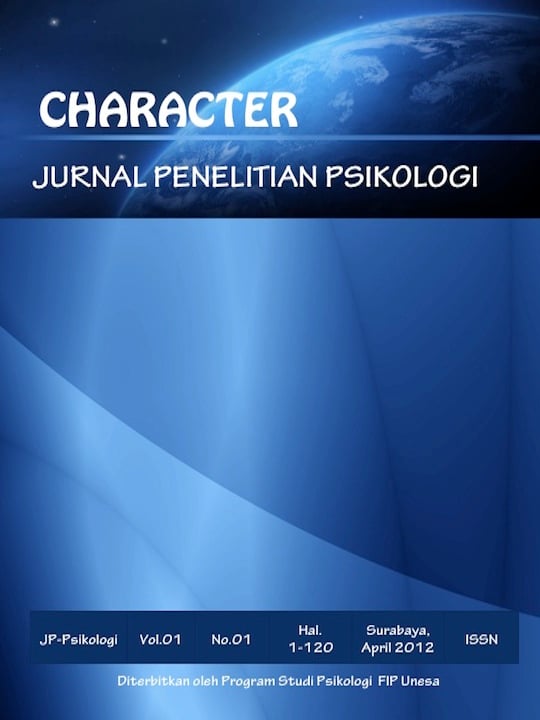GAMBARAN REGULASI EMOSI PADA IBU DENGAN ANAK DISLEKSIA
DOI:
https://doi.org/10.26740/cjpp.v9i6.47023Abstract
Abstrak
Penelitian ini memiliki tujuan untuk mengkaji proses dan faktor regulasi emosi seorang ibu yang memiliki seorang anak disleksia. Ketertarikan untuk meninjau persoalan ini didasari pada seorang ibu dengan anak disleksia yang mengalami gangguan kesehatan mental akibat kesulitan untuk melakukan regulasi emosinya. Seorang ibu memiliki peranan yang sangat penting dalam mengasuh, mendidik, dan merawat anak. Hal ini tidak mudah ditambah kondisi anak yang memiliki kebutuhan khusus salah satunya disleksia. Penelitian ini diharapkan dapat bermanfaat sebagai referensi cara regulasi emosi pada ibu yang memiliki anak disleksia. Penelitian ini berupa penelitian kualitatif bermetodekan studi kasus dengan tiga partisipan. Studi kasus dipilih untuk dapat mendalami peneliti memilih pendekatan studi kasus dikarenakan memiliki potensi untuk membantu memberikan pemahaman secara mendalam mengenai gambaran regulasi emosi pada ibu dengan anak disleksia serta faktor yang mempengaruhinya. Berdasarkan latar belakang, wawancara, dan observasi maka diperoleh hasil analisis bahwasanya regulasi emosi ibu dengan anak disleksia melalui proses yang tidak mudah. Ketiga partisipan melewati tiga proses regulasi emosi yaitu emotion monitoring, emotion evaluating, dan emotion modification. Regulasi emosi ibu dipengaruhi oleh beberapa faktor yaitu waktu dan usia, attachment ibu dengan anak, dan hubungan interpersonal ibu dengan keluarga inti atau orang lain.
Kata Kunci: regulasi emosi, ibu, anak disleksia
Abstract
This study aims to examine the process and factors of emotional regulation of a mother who has a dyslexic child. Interest in reviewing this issue is based on a mother with a dyslexic child who has a mental health disorder due to difficulty in regulating her emotions. A mother has a very important role in nurturing, educating, and caring for children. This is not easy plus the condition of children who have special needs, one of which is dyslexia. This research is expected to be useful as a reference for how to regulate emotions in mothers who have dyslexic children. This research is in the form of qualitative research coded case studies with three participants. Case studies are chosen to be able to explore researchers choosing a case study approach because it has the potential to help provide an in- depth understanding of the picture of emotion regulation in mothers with dyslexic children and the factors that influence it. Based on the background, interviews, and obeservation the results of the analysis obtained that the regulation of the emotions of mothers with dyslexic children through a process that is not easy. The three participants went through three emotional regulation processes, namely emotion monitoring, emotion evaluating, and emotion modification. Maternal emotion regulation is influenced by several factors, namely time and age, maternal attachment to the child, and the mother's interpersonal relationship with the nuclear family or others.
Keywords: emotion regulation, mother, dyslexic child
Downloads
Downloads
Published
How to Cite
Issue
Section
License
Authors who publish in this journal agree to the following terms:
Copyright in any article is held by the author.
The author grants the journal, publication rights with the work simultaneously licensed under a Creative Commons Attribution License that allows others to share the work with an acknowledgment of the work's authorship and initial publication in this journal.
Authors may enter into separate, additional contractual arrangements for the non-exclusive distribution of the journal's published version of the work (e.g., posting it to an institutional repository or publishing it in a book), with an acknowledgment of its initial publication in this journal.
Authors are permitted and encouraged to post their work online (e.g., in an institutional repository or on their website) prior to and during the submission process, as this can lead to productive exchanges, as well as earlier and greater citation of published work.
 Abstract views: 800
,
Abstract views: 800
, PDF Downloads: 1343
PDF Downloads: 1343





